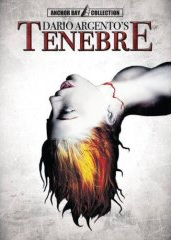
The Giallo has long courted both controversy and admiration for its fetishistic emphasis on stylized graphic violence, sexual obsession, and psychotic characters. This sharp--edged form of cinema often utilizes 'fragmented perception' as a something of a character itself, submerging us into the POV of the killer as we see the mystery unravelling. Perception is the bloody king of the Giallo, frequently popping up as characters struggle to unravel the mysteries of a central murder (or murders) and their own flawed senses. Specializing in convoluted plots, perverse imagery, and offbeat characters whose shifting perceptions hold deadly secrets, Giallo evokes both the horror of corrupted/damaged flesh and celebrates the lust of flesh in loving color; at the same time, it evokes emotional terrors of betrayal, the modern world's sense of alienation, and the threat of loss. Dario Argento, perhaps the most celebrated practitioner of this violent crime film, celebrates visual excess, weaving together the baroque and gothic into sharply edged modern horror. His work defies the traditional formula of his native country's murder mysteries by paying a generous amount of attention to the story itself. While often as fragmented as the body parts he so lovingly films, and as mad as his script's killers, Argento's narratives are surprisingly intricate, devoted to revealing the hidden layers of character. Tenebre explores the deception of appearances and the violent urges of the human animal to both create and view. It is a welcome return to the form which he revolutionized and an expansion on it. While sex, death, and voyeurism are certainly emphasized, as is Argento's interwoven sense of subversive narrative structure and subjective style, the story itself is richer in subtext and more complex than expected.
In Tenebre the revolutionary spirit of the Giallo's traditional violent set pieces is strengthened by a story whose inner impulses of paranoia are easily as disturbing as the external acts of debauchery used to enact confusion and rage. Amidst the creative kill set pieces are thematic undercurrents of self-identity, the illusion of appearances, and the inability of the human mind to decipher information. What a story is about is often less important to the fan or critic of this specialized sub-genre as 'how' a film is approached. Style is more essential than subject. Not so here, in a story as thoughtful and reflective as it is nihilistic. Argento's approach both delights in and fears death. Sex and violence are fondled like a toy. The director of such iconic works as Deep Red returned here to the psychologically subversive thriller proper after his lyrical ballet of the supernatural Suspiria. He challenges what we perceive and how we interpret it. Tenebre is a self portrait and confession, examining the catalysts and consequences of violence in both life and entertainment. It is also an homage and, more complex, a confrontation with audiences that seek pleasure from witnessing violence. The story: Peter Neal, an American based mystery writer, conducts a book tour in Rome to promote his newest thriller Tenebre. He soon discovers that a sadistic, female-hating killer is murdering woman based on his fiction. This brazen and thoughtful contemplation on the relationship between fact and fiction, violent art and life, is treated seriously and mocked, as we see several self righteous journalists and activists not only showing their ignorance but, more damaging, giving one of the principle characters an idea based on the assumption that fictitious horror leads to actual brutality. Peter, with the help of his secretary, Anne (Daria Nicolodi), struggles to discover the killer's identity. To say more about this tightly knit, multi-faceted plot would risk giving away too much, and this story depends on surprise.
This bold and penetrating Giallo displayed hallmarks of post-modernism, self-referential long before it was clich�. Tenebre is nothing less than a fierce thumb in the face to the lazy critical assumption that artists making violent (or so called misogynistic) works are themselves disturbed. Argento parodies and mocks this idea at the same time that he asks us to enjoy his seething sado-violence. Simultaneously he asks us WHY we enjoy it! What part of the blame, if any, do we share when art and life interbreed? And which comes first, violent art or real life atrocity? This is a mature and tragic work -- a trick on sensibilities effective precisely because it gives the impression of having deceived without actually doing so. The mystery, like the horror, is inherent in the script, hidden in the film itself, masterfully conceived and executed. This makes it a movie focusing on story rather than the bloodshed which is often the major concern of the sub-genre.
Presented in anamorphic widescreen Anchor Bay makes Tenebre a pleasure to experience, capturing the film's color schemes and crisp photography. Finally presented in Anamorphic Widescreen in an aspect ratio of 1.85:1, the picture is bold and clean and vibrant. No scratches or grain interferes, and the visual intensity is wonderfully duplicated. Robust colors and technology join forces to present a cinematic portrait of obsession, madness, and opportunism of the most horrid and callous sort, occupying a shadow-land somewhere between sexually charged psychological deficiency and bloody realism. Dolby Digital 5.1 and Dolby Surround 2.0 tracks are both clean and efficient, displaying a nice range of effects and dialogue and no noticeable interference.
Extras are plentiful but all but one were taken from Anchor Bay's previous DVD release. "Commentary" with Argento and Claudio Simonetti is friendly and enthusiastic, followed by a Theatrical Trailer." Three "Making Of" features are included: "Voices of the Unsane," The Roving Camera Eye of Dario Argento," and "Creating the Sounds of Terror." Finally we have "Alternate End Credit Music" and a Dario Argento bio.
Review by William Simmons
| Released by ANCHOR BAY |
| Region 1 - NTSC |
| Not Rated |
| Extras : |
| see main review |